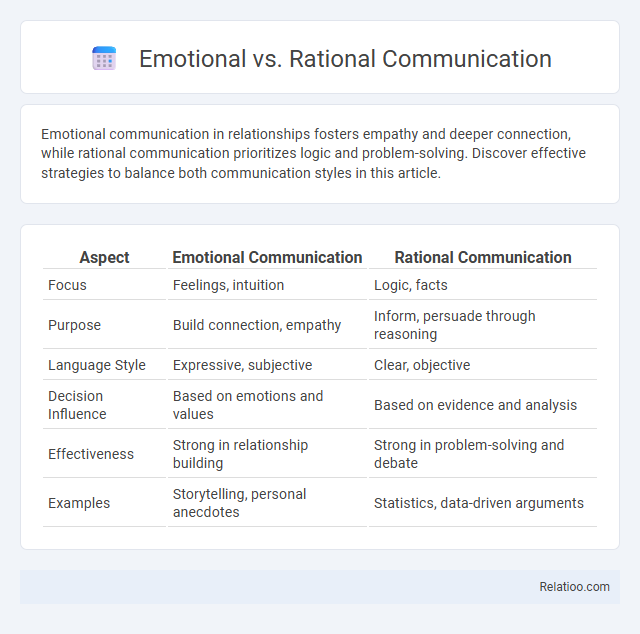Emotional communication in relationships fosters empathy and deeper connection, while rational communication prioritizes logic and problem-solving. Discover effective strategies to balance both communication styles in this article.
Table of Comparison
| Aspect | Emotional Communication | Rational Communication |
|---|---|---|
| Focus | Feelings, intuition | Logic, facts |
| Purpose | Build connection, empathy | Inform, persuade through reasoning |
| Language Style | Expressive, subjective | Clear, objective |
| Decision Influence | Based on emotions and values | Based on evidence and analysis |
| Effectiveness | Strong in relationship building | Strong in problem-solving and debate |
| Examples | Storytelling, personal anecdotes | Statistics, data-driven arguments |
Understanding Emotional and Rational Communication
Emotional communication centers on expressing feelings and building empathy, while rational communication focuses on logic, facts, and problem-solving. Your ability to differentiate between emotional and rational cues enhances effective dialogue and prevents misunderstandings. Recognizing these communication styles helps set clear boundaries, promoting respect and clarity in interactions.
Key Differences Between Emotional and Rational Messaging
Emotional communication appeals directly to Your feelings and personal experiences, often using stories, vivid imagery, and empathetic language to create a strong connection. Rational communication, in contrast, relies on logical arguments, facts, and data to persuade the audience through clear reasoning and evidence. The key difference lies in emotional messaging targeting subjective responses while rational messaging aims for objective understanding and decision-making.
The Psychology Behind Communication Styles
Emotional communication engages the limbic system, driving empathetic connection and immediate emotional responses, while rational communication activates the prefrontal cortex, fostering logical reasoning and analytical decision-making. Understanding these distinct neural pathways helps clarify how individuals establish personal boundaries by merging emotional openness with rational limits. This psychological interplay shapes effective interaction strategies, balancing emotional expression with cognitive control to maintain healthy interpersonal dynamics.
Benefits of Emotional Communication
Emotional communication fosters deeper connections and trust by allowing individuals to express genuine feelings and empathy, enhancing relational intimacy. It promotes better conflict resolution through understanding emotional cues and validating experiences, which reduces misunderstandings. Emphasizing emotional communication within boundaries enhances personal well-being and supports healthier, more authentic interactions.
Advantages of Rational Communication
Rational communication enhances clarity and reduces misunderstandings by focusing on facts and logical reasoning. This approach fosters effective problem-solving and decision-making, supporting stronger relationships by establishing clear boundaries. Prioritizing rational dialogue encourages respectful interactions and helps maintain emotional balance in challenging conversations.
When to Use Emotional Appeals
Emotional appeals are most effective when you want to create a personal connection or inspire action by tapping into your audience's feelings, such as during storytelling or crisis communication. You should use emotional communication to evoke empathy, build trust, or motivate change, especially when facts alone may not influence behavior. Understanding your boundaries ensures you don't manipulate emotions unfairly, keeping your message authentic and respectful to your audience's feelings.
Situations Favoring Rational Arguments
Situations favoring rational arguments often involve complex decisions requiring objective analysis, such as financial planning or technical problem-solving. You benefit from clear, data-driven communication when emotions might cloud judgment or lead to biased conclusions. Establishing boundaries in these contexts ensures discussions remain focused on facts and solutions rather than personal feelings.
Impact on Audience Decision-Making
Emotional communication taps into the audience's feelings, creating a connection that can influence decisions through empathy and personal relevance, often leading to quicker, instinctive choices. Rational communication appeals to logic and facts, encouraging analytical evaluation and critical thinking, which typically results in more deliberate and informed decisions. Clearly defined boundaries ensure messages remain credible and respectful, preventing emotional manipulation and fostering trust that supports balanced decision-making.
Balancing Emotion and Logic in Communication
Balancing emotion and logic in communication involves integrating emotional intelligence with rational analysis to enhance understanding and decision-making. Effective communicators recognize emotional cues while grounding their responses in objective facts, which fosters trust and clarity in both personal and professional interactions. Establishing clear boundaries ensures that conversations remain respectful and focused, preventing emotional bias from overwhelming logical reasoning.
Strategies to Enhance Communication Effectiveness
Effective communication balances emotional awareness with rational clarity, allowing you to express needs while respecting personal boundaries. Employ active listening techniques and validate feelings without compromising logical reasoning to foster mutual understanding. Establish clear boundaries by communicating them assertively and consistently, enhancing trust and preventing misunderstandings in both personal and professional interactions.

Infographic: Emotional vs Rational Communication
 relatioo.com
relatioo.com